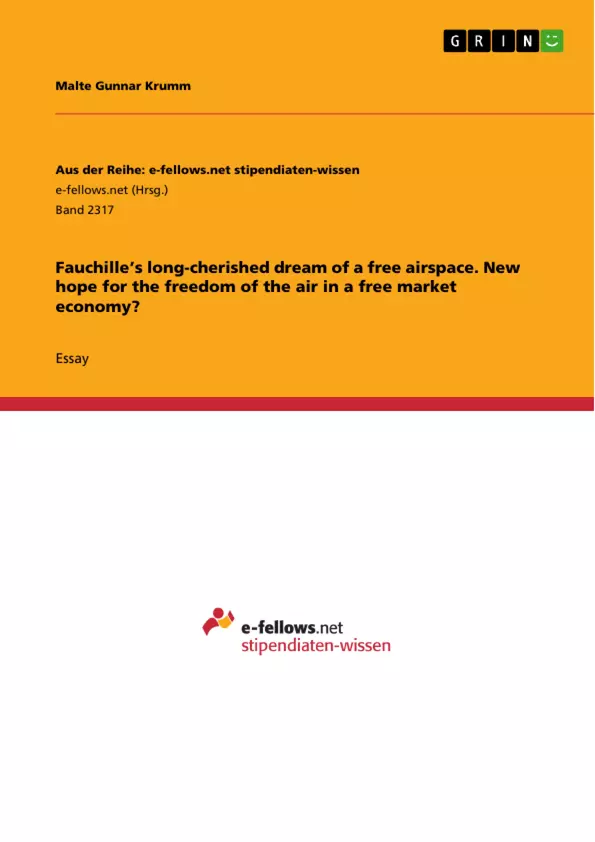When Paul Fauchille presented his dictum “[a]irspace should be free as the High Seas [...] States should only have the territorial powers up to an altitude of 300 metres." to the public in 1901, it did not take long until the international community disagreed strongly. The fear of espionage, attacks and other abuse was too great to give up sovereignty over the own territories’ airspace.
This essay presents Fauchille’s idea of the freedom of the air (Chapter 2) and compares it with a concept of airspace sovereignty (Chapter 3), focussing on origin, arguments, logical consistency as well as international and national state practice. Further, it will be analysed whether current trends towards a liberalised market in scheduled international civil aviation could influence the legal status of the air (Chapter 4). Finally, remaining fields of strict sovereignty on the international political stage will be identified (Chapter 5), before a conclusion is drawn (Chapter 6).
The legal status of the air was not questioned for a long time. The states’ inability to control the airspace and the circumstance that manned flights were not operated on a regular basis yet seems to have deterred states from any claims of sovereignty. However, the technological progress and the first short balloon flights in the late 18th century attracted the public’s attention. Among others, the French lawyer and pioneer of air law Paul Auguste Fauchille developed his own concept for the legal status of the air, which will be outlined in the next chapter.
Inhaltsverzeichnis (Table of Contents)
- Chapter 1 - Introduction
- Chapter 2 - Fauchille's Concept for the Air
- Chapter 2.1 - Freedom of the Air
- Chapter 2.2 - Arguments
- Chapter 2.3- Critique
- Chapter 2.4 National and International State Practice
- Chapter 3 - Airspace Sovereignty
- Chapter 3.1 - Origin
- Chapter 3.2 - Arguments
- Chapter 3.3 - State Practice and Legal Implementation
- Chapter 4 Commercial Airspace Liberalisation
- Chapter 4.1 Introduction
- Chapter 4.2 – Bilateral Air Service Agreements
- Chapter 4.3 – Open Skies Agreements
- Chapter 5 - Presence of strict Sovereignty
Zielsetzung und Themenschwerpunkte (Objectives and Key Themes)
This essay explores the concept of a free airspace as proposed by Paul Fauchille, analyzing its historical context, legal arguments, and contemporary relevance. It examines the evolution of airspace regulations, from the initial resistance to the idea of a free airspace to the increasing trend of airspace liberalization in a globalized market.
- Fauchille's concept of freedom of the air
- The evolution of airspace sovereignty
- The impact of technological advancements on airspace regulation
- The role of international treaties in shaping airspace law
- The interplay between airspace liberalization and national sovereignty
Zusammenfassung der Kapitel (Chapter Summaries)
Chapter 1: Introduction
This chapter introduces the historical context of the debate surrounding airspace sovereignty, highlighting the tension between the desire for freedom of the air and the concerns over national security and control. It outlines Fauchille's groundbreaking proposal for a free airspace, which, although rejected initially, has resurfaced in the context of current airspace liberalization trends.
Chapter 2: Fauchille's Concept for the Air
This chapter delves into Fauchille's vision of a free airspace, examining its historical precedents, the arguments in its favor, and the critical considerations surrounding it. It explores how Fauchille's concept was shaped by his understanding of sovereignty and the technological realities of his time, specifically the use of balloons.
Chapter 3: Airspace Sovereignty
This chapter analyzes the concept of airspace sovereignty, tracing its origins, arguments, and the interplay between national and international state practice. It examines the historical development of airspace sovereignty and the various legal and practical challenges it poses in the context of international relations.
Chapter 4: Commercial Airspace Liberalisation
This chapter explores the trend of airspace liberalization in the context of international civil aviation. It examines the role of bilateral and open skies agreements in promoting free market access and competition within the aviation sector, highlighting the potential implications for the legal status of the air.
Schlüsselwörter (Keywords)
The key themes of the text revolve around airspace law, freedom of the air, airspace sovereignty, international law, aviation, liberalization, international treaties, and the legal status of the air. These concepts are explored through the historical lens of Paul Fauchille's vision, considering the impact of technological advancements and the evolution of international relations.
- Quote paper
- Malte Gunnar Krumm (Author), 2017, Fauchille’s long-cherished dream of a free airspace. New hope for the freedom of the air in a free market economy?, Munich, GRIN Verlag, https://www.grin.com/document/359335



